|
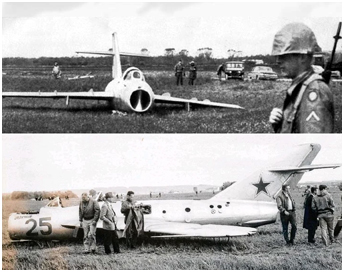
 On 25 May, a squadron of Soviet Fresco aircraft (MIG-17) took off from a base in the Carpathian Military District USSR (> Link)
for what was to have been a routine bombing exercise in East Germany. The plan called for a landing at Finsterwalde Airfield; refueling and taking off for a bomb run at the Belgern bombing range; and
then deploying back to home base in the USSR.
The aircraft, flying in trail approximately five minutes apart and at an altitude of approximately 3000 feet, had made their course correction north of Dresden to a heading direct to Finsterwalde.
That is, all but one. Sr. Lt. Yepatko, an outstanding pilot, flying next to the last aircraft, had reached his own personal moment of truth. Instead of veering north to a heading of 330 degrees he
banked to the southwest, increased to full throttle and dove for the ground. Levelling out at approximately 200 feet altitude he followed the mountains peaks in Western Czechoslovakia in the
general direction of Bavaria. After his ten minutes of full speed at breakaway, he throttled back to save fuel and continued at tree-top level to his landing area northwest of Augsburg, Federal Republic
of Germany, where he made a superb crash landing. This was in keeping with Yepatko's rating painted on the nose of his aircraft - "otlichno (outstanding)." [rather a marking indicating that the team of mechanics assigned
to this aircraft was above average].
The sensational news hit the press immediately, and by coincidence the Chief of USMLM and the Air Team Chief were on TDY at USAREUR and USAFE Headquarters respectively when official word of the defection
arrived. Meanwhile, back at the Mission on the following day, word was received from SERB [Soviet External Relations Branch at Potsdam] that the Chief of Staff, GSFG desired an immediate meeting
with Colonel McCord (by name) at Wuensdorf, GSFG Headquarters. Deputy Chief, LTC Callahan, accompanied by LTC Szymczyk, attended as the Chief's representatives and were told, in a polite manner, that the
CINC GSFG [Army General P. K. Kochevoy] demanded from CINC USAREUR [General Andrew P. O'Meara until June 1, 1967] the retrun of the plane and pilot to Soviet authorities.
Unknown to the Soviets, the US State Department had already approved the return of the aircraft, through SERB, with details to be worked out. However, Sr. Lt. Yepatko had asked for asylum and for no
confrontation with the Soviets, and the Soviets were so informed through SERB on 27 May.
On the following day, 28 May, HQ GSFG expressed to HQ USAREUR, through SERB, that they were prepared to accept the aircraft near Hirschberg (state border of GDR and FRG); and that they demanded that
Chief of Soviet Military Liaison Mission, Frankfurt, be allowed to meet with Pilot Yepatko.
On 25 May, a squadron of Soviet Fresco aircraft (MIG-17) took off from a base in the Carpathian Military District USSR (> Link)
for what was to have been a routine bombing exercise in East Germany. The plan called for a landing at Finsterwalde Airfield; refueling and taking off for a bomb run at the Belgern bombing range; and
then deploying back to home base in the USSR.
The aircraft, flying in trail approximately five minutes apart and at an altitude of approximately 3000 feet, had made their course correction north of Dresden to a heading direct to Finsterwalde.
That is, all but one. Sr. Lt. Yepatko, an outstanding pilot, flying next to the last aircraft, had reached his own personal moment of truth. Instead of veering north to a heading of 330 degrees he
banked to the southwest, increased to full throttle and dove for the ground. Levelling out at approximately 200 feet altitude he followed the mountains peaks in Western Czechoslovakia in the
general direction of Bavaria. After his ten minutes of full speed at breakaway, he throttled back to save fuel and continued at tree-top level to his landing area northwest of Augsburg, Federal Republic
of Germany, where he made a superb crash landing. This was in keeping with Yepatko's rating painted on the nose of his aircraft - "otlichno (outstanding)." [rather a marking indicating that the team of mechanics assigned
to this aircraft was above average].
The sensational news hit the press immediately, and by coincidence the Chief of USMLM and the Air Team Chief were on TDY at USAREUR and USAFE Headquarters respectively when official word of the defection
arrived. Meanwhile, back at the Mission on the following day, word was received from SERB [Soviet External Relations Branch at Potsdam] that the Chief of Staff, GSFG desired an immediate meeting
with Colonel McCord (by name) at Wuensdorf, GSFG Headquarters. Deputy Chief, LTC Callahan, accompanied by LTC Szymczyk, attended as the Chief's representatives and were told, in a polite manner, that the
CINC GSFG [Army General P. K. Kochevoy] demanded from CINC USAREUR [General Andrew P. O'Meara until June 1, 1967] the retrun of the plane and pilot to Soviet authorities.
Unknown to the Soviets, the US State Department had already approved the return of the aircraft, through SERB, with details to be worked out. However, Sr. Lt. Yepatko had asked for asylum and for no
confrontation with the Soviets, and the Soviets were so informed through SERB on 27 May.
On the following day, 28 May, HQ GSFG expressed to HQ USAREUR, through SERB, that they were prepared to accept the aircraft near Hirschberg (state border of GDR and FRG); and that they demanded that
Chief of Soviet Military Liaison Mission, Frankfurt, be allowed to meet with Pilot Yepatko.
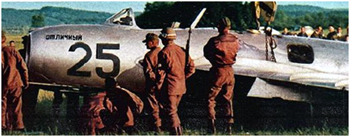
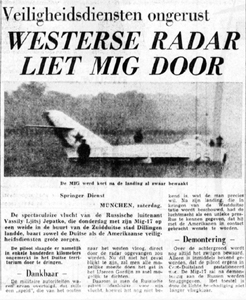 De Telegraaf, 28 mai 1967.
De Telegraaf, 28 mai 1967.
De Telegraaf, May 28, 1967.
Chief USMLM, having returned from Heidelberg, 29 May, recommended the transfer site be the Wartha-Herleshausen border control point. He also prepared a draft transfer document ("AKT") to acknowledge transfer
of the aircraft remains. These were duly accepted by USAREUR.
On 31 May, Chief USMLM was again called to HQ USAREUR. A commission of two (Chief and Air Team Chief USMLM) was established to transfer the MIG-17, subsequently agreed for 2 June. The Soviets were advised
of the place of transfer, the need for a lowboy for the aircraft, a 2-1/2 ton truck for loose parts and pieces, and a crane to effect the transfer.
Because transfer would occur in the Federal Republic of Germany, the Soviets were requested to present a list of commission personnel and workers involved in the aircraft transfer. West German authorities
[representatives of which would also be present] agreed that Chief USMLM could check all Soviet personnel and vehicles into the FRG. The Soviets were advised that the aircraft could not be moved from Augsburg
to Wartha-Herleshausen intact and thus there would be "some" loose parts. It was not revealed that the aircraft had been well exploited by USAFE representatives.
On 2 June at 1000 hours, Chief USMLM met Colonel Kazarov, Chief of the Soviet commission, at the checkpoint and cleared the Soviet personnel and vehicles into the FRG. Colonel Kazarov was belligerent and
uncooperative at first, declaring that the location Chief USMLM had picked for transfer was unsuitable and that there was too large a crowd of people observing the procedure. Chief USMLM allowed Colonel
Kazarov to pick a more suitable place to spot the crane and the two lowboys, but told him that the spectators were free to observe so long as they did not interfere with the safety of the operation.
Kazarov remained surly, and told Chief USMLM he could not accept the aircraft until his team of specialists had inspected it. Kazarov was informed that he was free to inspect the aircraft, but that he
would be allowed only 30 minutes to do so and to sign the US transfer document; otherwise Chief USMLM was authorized to return the aircraft to US Headquarters. Soviet technicians then jumped on the
aircraft, and in less that two minutes reported to Kazarov that certain items were missing. When questioned about this, Chief USMLM advised Kazarov that the "AKT" stated that "remains of an aircraft",
and not an intact aircraft, would be transferred. Kazarov was obviously put out and stated that he had seen a photograph of a completely intact aircraft in the Stars and Stripes. Chief USMLM explained
that the aircraft had been subject to "sightseers and picnickers" before coming into US control. He stated that his CINC had not sent him to argue, but rather to transfer aircraft remains. If the Soviets had
a complaint, they knew the proper channels in which to register it.
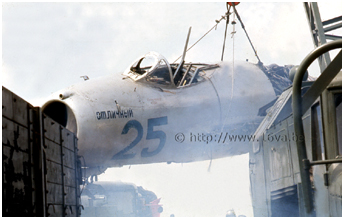
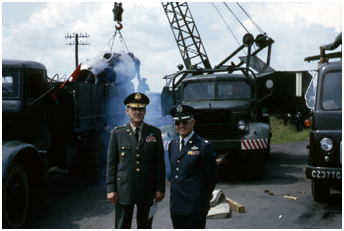 Colonel Kazarov requested a five minute adjournment to check with his authorities. Chief USMLM agreed, reminding Colonel Kazarov of the waning time. In approximately five minutes, Colonel Kazarov
returned from the East German side and stated Soviet acceptance of the aircraft. While the transfer "AKT" was being translated and typed, the Soviets tried to start unloading the aircraft. These actions
were halted by the USMLM commission until the "AKT" was signed.
Final signing by Colonel McCord and LTC Puchrik was effected in Colonel Kazarov's VOLGA automobile. Unloading and transfer of the aircraft, then authorized, was accomplished swiftly and smoothly.
At 1245 hours the Soviets, with aircraft in tow, departed through the Wartha-Herleshausen exit point, and Chief USMLM made his final report to DCSI [Deputy Chief of Staff Intelligence],
Heidelberg, via radio-telephone.
Prior to departure, Colonel McCord complimented the Soviets on a professional job, well-done, and he invited Colonel Kazarov to be his guest at Potsdam. Colonel Kazarov expressed his thanks
but stated that he "seldom ever gets to Potsdam." The final word on the transfer was registered by Colonel Pinchuk, Chief SERB, who met the Soviet convoy as it returned to East Germany. He angrily
remarked to Deputy Chief USMLM, LTC Callahan, that the Americans should have gotten all the parts together and anyway what did they want with the missing ammunition. He threatened further
discussion on the whereabouts of the missing elements. As of the end of 1967, no protest from GSFG had been directed through USMLM channels, altough it was learned that a protest had been made to
the government of the Federal Republic of Germany.
Colonel Kazarov requested a five minute adjournment to check with his authorities. Chief USMLM agreed, reminding Colonel Kazarov of the waning time. In approximately five minutes, Colonel Kazarov
returned from the East German side and stated Soviet acceptance of the aircraft. While the transfer "AKT" was being translated and typed, the Soviets tried to start unloading the aircraft. These actions
were halted by the USMLM commission until the "AKT" was signed.
Final signing by Colonel McCord and LTC Puchrik was effected in Colonel Kazarov's VOLGA automobile. Unloading and transfer of the aircraft, then authorized, was accomplished swiftly and smoothly.
At 1245 hours the Soviets, with aircraft in tow, departed through the Wartha-Herleshausen exit point, and Chief USMLM made his final report to DCSI [Deputy Chief of Staff Intelligence],
Heidelberg, via radio-telephone.
Prior to departure, Colonel McCord complimented the Soviets on a professional job, well-done, and he invited Colonel Kazarov to be his guest at Potsdam. Colonel Kazarov expressed his thanks
but stated that he "seldom ever gets to Potsdam." The final word on the transfer was registered by Colonel Pinchuk, Chief SERB, who met the Soviet convoy as it returned to East Germany. He angrily
remarked to Deputy Chief USMLM, LTC Callahan, that the Americans should have gotten all the parts together and anyway what did they want with the missing ammunition. He threatened further
discussion on the whereabouts of the missing elements. As of the end of 1967, no protest from GSFG had been directed through USMLM channels, altough it was learned that a protest had been made to
the government of the Federal Republic of Germany.
Colonel McCord, Chief USMLM - 1967
|










